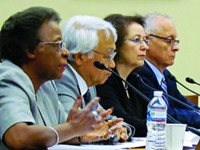Advertisement
Grab your lab coat. Let's get started
Welcome!
Welcome!
Create an account below to get 6 C&EN articles per month, receive newsletters and more - all free.
It seems this is your first time logging in online. Please enter the following information to continue.
As an ACS member you automatically get access to this site. All we need is few more details to create your reading experience.
Not you? Sign in with a different account.
Not you? Sign in with a different account.
ERROR 1
ERROR 1
ERROR 2
ERROR 2
ERROR 2
ERROR 2
ERROR 2
Password and Confirm password must match.
If you have an ACS member number, please enter it here so we can link this account to your membership. (optional)
ERROR 2
ACS values your privacy. By submitting your information, you are gaining access to C&EN and subscribing to our weekly newsletter. We use the information you provide to make your reading experience better, and we will never sell your data to third party members.
Research Integrity
Improving Technology Transfer
House subcommittee examines how government can help commercialize basic research
by Linda Wang
July 5, 2010
| A version of this story appeared in
Volume 88, Issue 27

The National Science Foundation could play an expanded role in supporting the commercialization of federally funded research. This shift would benefit society and strengthen the nation’s competitiveness, a group of stakeholders told the House Science & Technology Committee’s Subcommittee on Research & Science Education during a hearing last month. The subcommittee organized the hearing to review the technology transfer process that academic researchers use to move their work into the private sector.
NSF “needs to be a catalyst for encouraging the development of business skills among science, technology, engineering, and mathematics students,” Neil D. Kane said at the hearing. Kane is the president and cofounder of Advanced Diamond Technologies, a company commercializing technology from Argonne National Laboratory. NSF also “has a mission and voice in government to encourage university policy to make sure that efforts that faculty undergo to help start businesses are not viewed neutrally or negatively on their tenure track or professor trajectories,” Kane added.
“If you do those two things, you would remove the stigma among academics” associated with “pursuing start-up businesses and, instead, have that be encouraged,” Kane continued. “I think there would be quite an explosion of new businesses,” he added.
NSF is not in a position to make “wholesale changes” to the technology transfer process, said Thomas W. Peterson, assistant director of NSF’s Engineering Directorate. “But what we can do is recognize that as part of the criteria for next steps in support, one looks not only at the technical content and technical strength but also at the university’s capacity to handle these kinds of entrepreneurial activities.”
The stakeholders—representing academia, industry, government, venture capitalists, and private foundations—also told lawmakers that university faculty members need incentives to participate in the technology transfer process. “We need to create an ecosystem within the university to make it easy for faculty to participate [in technology transfer], for them to see this as a logical part of their scholarly and intellectual endeavors,” said W. Mark Crowell, executive director and associate vice president for innovation partnerships and commercialization at the University of Virginia. “I believe that the rewards and recognition from that will follow in due course.”
In addition, “if we are interested in commercializing science at the level of our universities, we need to develop broad commercialization education programs,” said Lesa Mitchell, vice president of advancing innovation at the Ewing Marion Kauffman Foundation.
Mitchell and other stakeholders urged the subcommittee to allocate more funding for NSF to drive technology transfer at the university level. The agency would use the money to support proof-of-concept and translational research programs and entrepreneurial education.
“We need to be looking more closely at how we can best help our universities—filled with the world’s best researchers—continue to be economic engines that power America’s future,” subcommittee Chairman Daniel Lipinski (D-Ill.) said. “Countries like China and members of the European Union are now investing heavily in their own R&D programs. They are determined to move up the value chain, and we need sustained investments and smart policies if we want to remain the world leader in science and technology.”
Other stakeholders who testified offered ways to remove barriers to faculty participation in technology transfer. One barrier is “archaic conflict-of-interest policies,” according to Keith L. Crandell, cofounder and managing director of Arch Venture Partners, which invests in companies cofounded by scientists and entrepreneurs operating in the areas of life sciences, physical sciences, and information technologies. He suggested that scientists involved in entrepreneurial activities should be penalized for actual conflict and not just the appearance of conflict.
Changing entrenched attitudes in academia, however, would be difficult. Although some faculty members have received tenure or promotion on the basis of entrepreneurial activity in addition to research and teaching, those have been few and far between, pointed out Wayne H. Watkins, associate vice president for research at the University of Akron. “We have a long way to go; it’s a culture adjustment that needs to occur, and it’s going to be dependent upon leaders as well as faculty,” Watkins said. “As faculty become more aware of what this innovation system is all about, we think it will come. It’s just too slow for me.”g




Join the conversation
Contact the reporter
Submit a Letter to the Editor for publication
Engage with us on Twitter